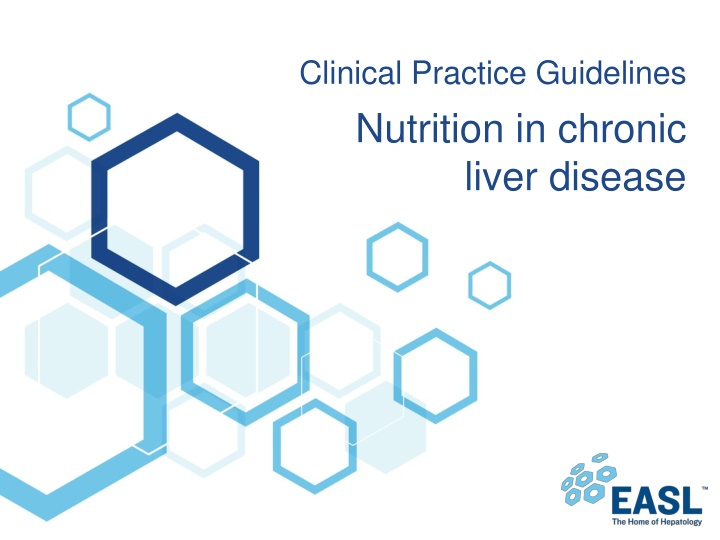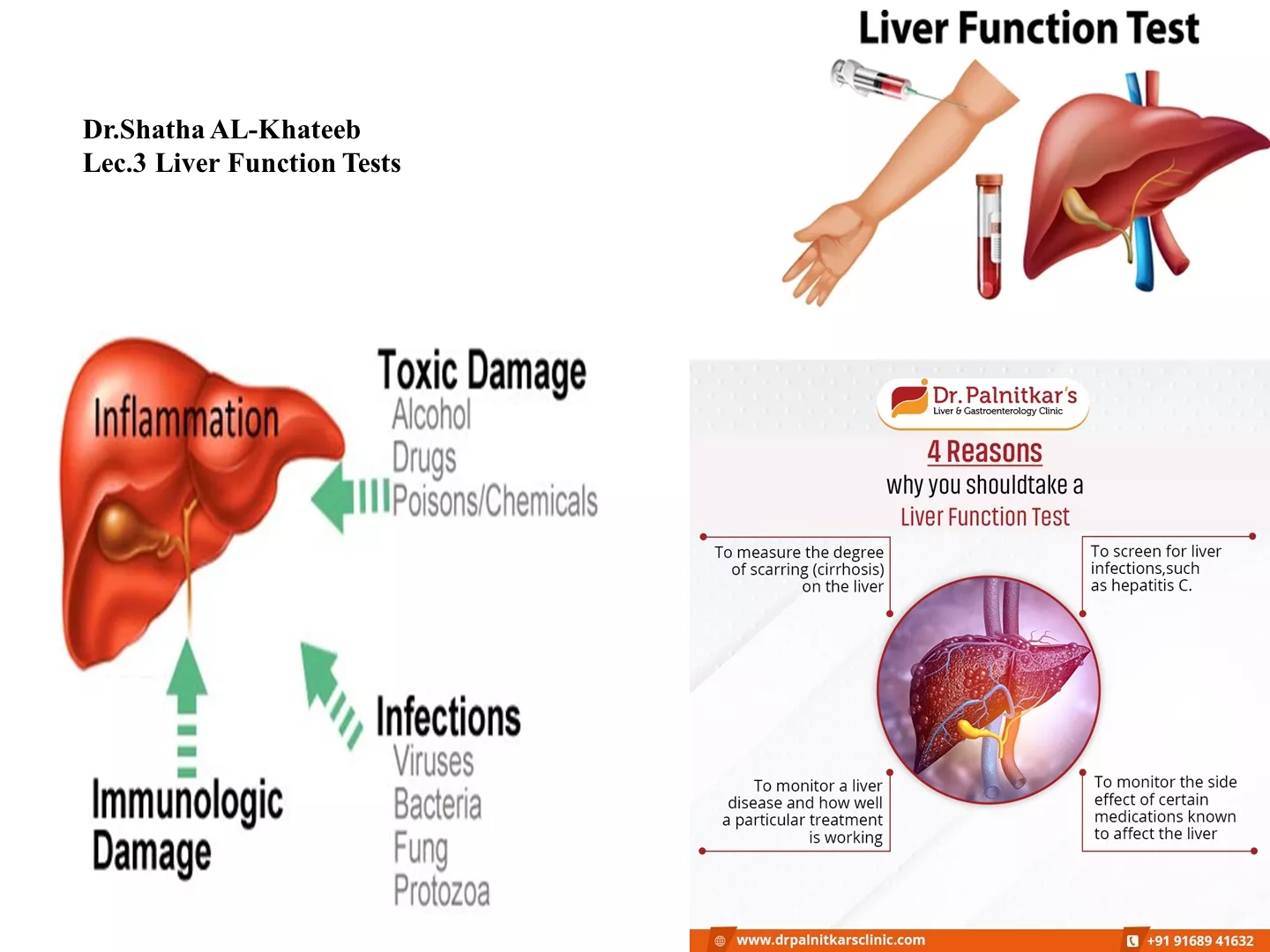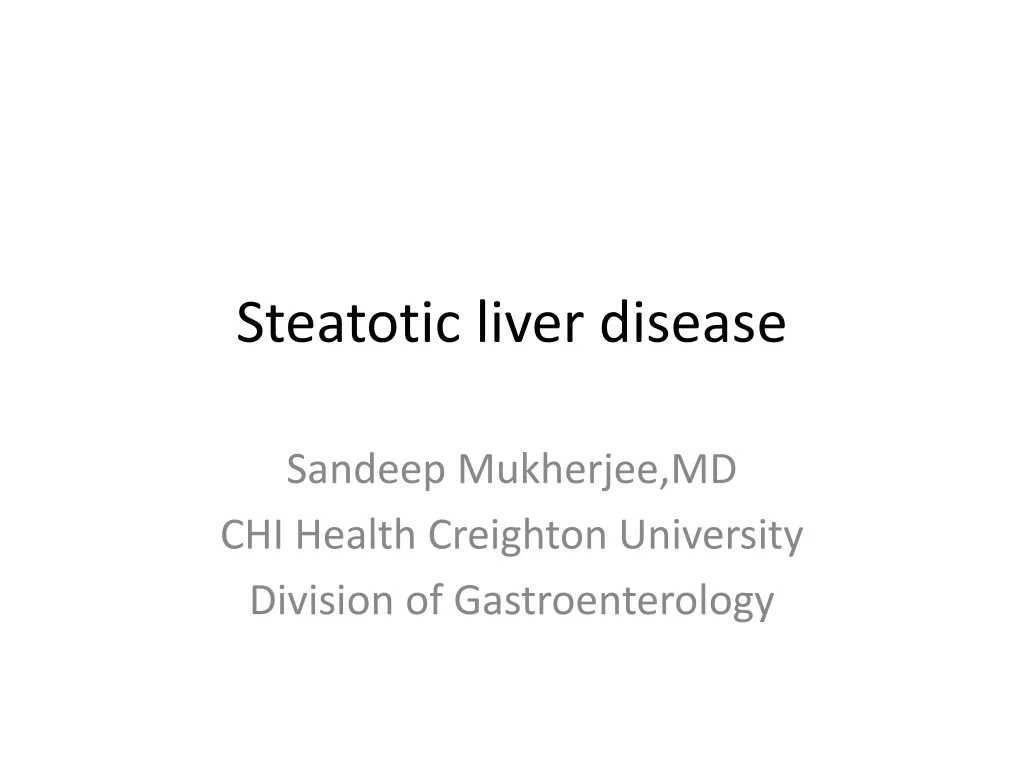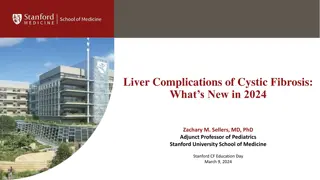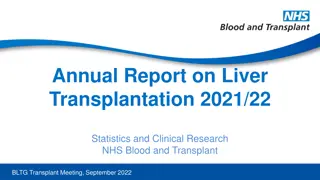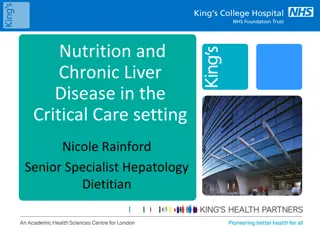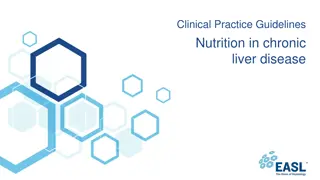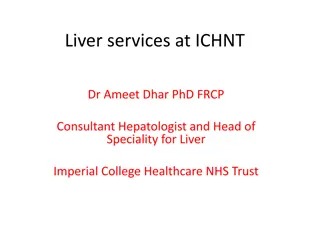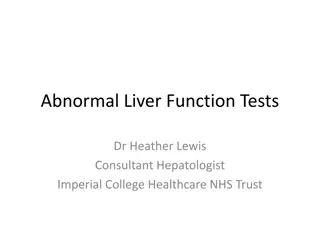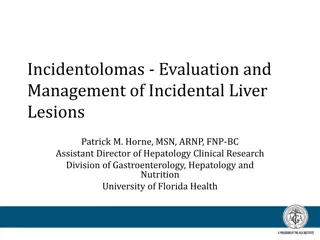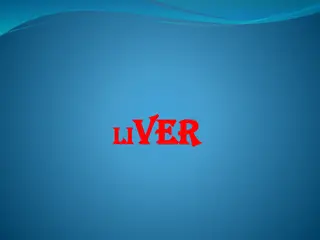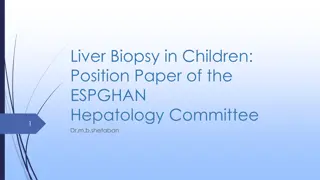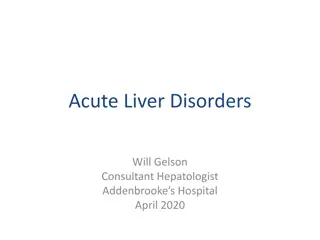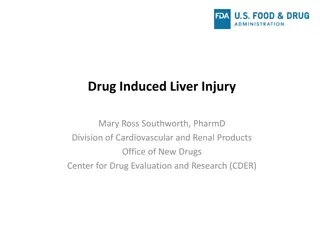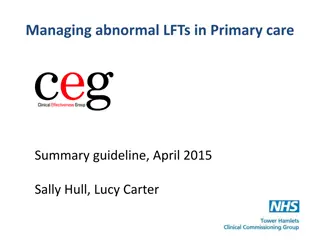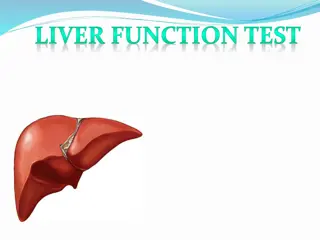Clinical Practice Guidelines: Nutrition in Chronic Liver Disease Overview
These slides provide a comprehensive overview of the EASL clinical practice guidelines on nutrition in chronic liver disease. The guidelines were first presented at the International Liver Congress 2018 and will soon be published in the Journal of Hepatology. The content covers methods of grading evidence and recommendations, key recommendations, unresolved issues, and the guideline panel members. It emphasizes the importance of proper nutrition in managing chronic liver disease and offers valuable insights for healthcare professionals. The slides serve as an educational resource and caution against making patient management decisions based solely on this material.
Download Presentation

Please find below an Image/Link to download the presentation.
The content on the website is provided AS IS for your information and personal use only. It may not be sold, licensed, or shared on other websites without obtaining consent from the author.If you encounter any issues during the download, it is possible that the publisher has removed the file from their server.
You are allowed to download the files provided on this website for personal or commercial use, subject to the condition that they are used lawfully. All files are the property of their respective owners.
The content on the website is provided AS IS for your information and personal use only. It may not be sold, licensed, or shared on other websites without obtaining consent from the author.
E N D
Presentation Transcript
Clinical Practice Guidelines Nutrition in chronic liver disease
About these slides These slides give a comprehensive overview of the EASL clinical practice guidelines on nutrition in chronic liver disease The guidelines were first presented at the International Liver Congress 2018 and will be published soon in the Journal of Hepatology The full publication will be downloadable from the Clinical Practice Guidelines section of the EASL website once available Please feel free to use, adapt, and share these slides for your own personal use; however, please acknowledge EASL as the source
About these slides Definitions of all abbreviations shown in these slides are provided within the slide notes When you see a home symbol like this one: , you can click on this to return to the outline or topics pages, depending on which section you are in These slides are intended for use as an educational resource and should not be used in isolation to make patient management decisions. All information included should be verified before treating patients or using any therapies described in these materials Please send any feedback to: slidedeck_feedback@easloffice.eu
Guideline panel Chair Manuela Merli Panel members Shira Zelber-Sagi, Srinivasan Dasarathy, Sara Montagnese, Laurence Genton, Mathias Plauth, Albert Par s, Annalisa Berzigotti (EASL Governing Board Representative)
Outline Methods Grading evidence and recommendations Methods Grading evidence and recommendations Background Present knowledge Background Present knowledge Guidelines Key recommendations Guidelines Key recommendations The future Unresolved issues The future Unresolved issues
Methods Grading evidence and recommendations
Grading evidence and recommendations Grading is adapted from the GRADE system1 Grade of evidence I Randomized, controlled trials II-1 Controlled trials without randomization II-2 Cohort or case-control analytical studies II-3 Multiple time series, dramatic uncontrolled experiments III Opinions of respected authorities, descriptive epidemiology Evidence quality A High B Moderate C Low Grade of recommendation 1 Strong recommendation: Factors influencing the strength of the recommendation included the quality of the evidence, presumed patient-important outcomes, and cost 2 Weaker recommendation: Variability in preferences and values, or more uncertainty: more likely a weak recommendation is warranted Recommendation is made with less certainty: higher cost or resource consumption 1. Guyatt GH, et al. BMJ 2008:336:924 6
Methods Questions to address were first established, taking into account relevance, urgency and completeness of each Key questions addressed: How to recognize nutritional problems. In which conditions is nutritional assessment recommended? What are the available methods of evaluation? What are the consequences of malnutrition and its correction in different clinical scenarios Nutrition in chronic liver disease Nutrition in hepatic encephalopathy Nutrition before and after liver transplantation Bone metabolism in chronic liver disease A literature search was performed in different databases to identify references. Pertinent key words were defined for each specific topic of the Guideline Reference selection was based on appropriateness of study design, number of patients, and publication in peer-reviewed journals. Original data were prioritised
Background The burden of malnutrition in liver cirrhosis Malnutrition definition Mechanisms and potential targets for sarcopenia
Prevalence and implications of malnutrition and sarcopenia in cirrhosis Malnutrition is a frequent burden in liver cirrhosis; reported in 20% of patients with compensated cirrhosis and in more than 50% of patients with decompensated liver disease The progression of malnutrition is associated with the progression of liver failure, and while malnutrition may be less evident in compensated cirrhosis, it is easily recognizable in decompensated patients Both adipose tissue and muscle tissue can be depleted; female patients more frequently develop a depletion in fat deposits while males more rapidly lose muscle tissue
Prevalence and implications of malnutrition and sarcopenia in cirrhosis Malnutrition and muscle mass loss (sarcopenia), which has been often used as an equivalent of severe malnutrition, are associated with a higher rate of complications Susceptibility to infections Hepatic encephalopathy Ascites Independent predictors of lower survival in cirrhosis and in patients undergoing liver transplantation Given these observations, malnutrition and sarcopenia should be recognized as a complication of cirrhosis, which in turn further worsens the prognosis of cirrhotic patients
Malnutrition definition The term malnutrition refers both to deficiencies and to excesses in nutritional status. In the present guidelines, we identify malnutrition with undernutrition More recently, in addition to undernutrition, cirrhotic patients who are overweight or obese are increasingly being observed due to the increased number of cirrhosis cases related to NASH Muscle mass depletion may also occur in these patients, but due to the coexistence of obesity, sarcopenia might be overlooked Obesity and sarcopenic obesity may worsen the prognosis of patients with liver cirrhosis
Terminology Deterioration of muscle functional capacity related to immobility and chronic debilitating disease Loss of functional, cognitive, and physiological reserve leading to a vulnerable state. Frailty may be considered a form of nutrition-related disorder Use of specific nutrients in an attempt to modulate the immune system (not necessarily in the presence of malnutrition) and function to improve health state. Examples include enteral nutritional formulas enriched with -3 fatty acids, arginine, glutamine and nucleotides A nutrition-related disorder resulting from lack of intake or uptake of nutrition that leads to altered body composition (decreased fat-free mass) and body cell mass leading to diminished physical and mental function and impaired clinical outcome from disease. In the present CPG, we have used malnutrition as a synonym of undernutrition The active, progressive loss of muscle mass due to an underlying disease, ultimately leading to muscle atrophy. Most inflammatory diseases induce muscle wasting Reduction in muscle mass and function due to ageing (primary sarcopenia), acute or chronic illness (secondary sarcopenia), including chronic liver disease Synonym of malnutrition (see above) Deconditioning Frailty Immunonutrition Malnutrition Muscle wasting Sarcopenia Undernutrition
Mechanisms resulting in sarcopenia and failure to respond to standard supplementation Anabolic resistance and dysregulated proteostasis result in failure to respond to standard supplementation These mechanisms represent potential therapeutic targets
Guidelines Key recommendations
Topics 1. Screening and assessment for malnutrition and obesity in liver cirrhosis: who, when and how Nutritional management principles in patients with liver cirrhosis Micronutrients Nutritional treatment options for hepatic encephalopathy Nutritional treatment options in cirrhotic patients with bone diseases Malnutrition in patients undergoing liver surgery and liver transplantation Malnutrition in critically ill cirrhotic patients The future for nutrition in chronic liver disease 2. 3. 4. 5. 6. 7. 8.
Screening and assessment for malnutrition and obesity in liver cirrhosis: who, when and how Grade of evidence Grade of recommendation Recommendations Perform rapid nutritional screen in all patients with cirrhosis and complete a detailed assessment in those at risk of malnutrition to confirm the presence and severity of malnutrition Assume risk for malnutrition to be high if BMI <18.5 kg/m2 or Child Pugh C. In all other instances, utilize nutritional screening tools to assess the risk of malnutrition In the diagnosis of obesity (BMI >30 kg/m2) take care of the confounding effect of fluid retention. Estimate dry body weight, although accuracy is low II-2 B 1 II-2 B 1 II-2 B 1
Screening and assessment for malnutrition and obesity in liver cirrhosis: who, when and how Grade of evidence Grade of recommendation Recommendations Always include an assessment of sarcopenia within the nutritional assessment Assess muscle mass by CT imaging, where this is available (having been performed for other purposes). Anthropometry, DEXA or BIA are possible alternatives, which also allow serial measurements Assess muscle function, in the clinical setting, with the most appropriate tool such as handgrip strength (HGS) and the Short Physical Performance Battery (SPPB) Assess dietary intake by trained personnel (ideally a dietician with knowledge of managing patients with liver disease) working as part of a team with the hepatologist. Assessment should include: quality and quantity of food and supplements, fluids, sodium in diet, number and timing of meals during the day and barriers for eating II-2 B 1 II-2 B 1 II-2 B 1 II-2 B 1
Nutritional screening and assessment in patients with cirrhosis In a case of fluid retention, body weight should be corrected by evaluating the patient s dry weight by post-paracentesis body weight or weight recorded before fluid retention if available, or by subtracting a percentage of weight based upon severity of ascites (mild, 5%; moderate, 10%; severe, 15%), with an additional 5% subtracted if bilateral pedal oedema is present
Nutritional management principles in patients with liver cirrhosis Grade of evidence Grade of recommendation Recommendations Start nutritional counselling by a multidisciplinary team supporting the patient for adequate calories and protein intake in patients with malnutrition and cirrhosis Optimal daily energy intake should not be lower than the recommended 35 kcal/kg actual body weight II-2 C 1 II-2 B 1 Optimal daily protein intake should not be lower than the recommended 1.5 g/kg actual body weight Include late evening oral nutritional supplementation (ONS) and breakfast containing some proteins in malnourished decompensated cirrhotic patients BCAA supplements and leucine enriched amino acid supplements should be considered in decompensated cirrhotic patients In patients with malnutrition and cirrhosis who are unable to achieve adequate dietary intake with the oral diet (even with oral supplements), a period of enteral nutrition is recommended II-2 B II-1 B 1 II-1 B 1 II-1 B 1
Nutritional management principles in patients with liver cirrhosis Grade of evidence Grade of recommendation Recommendations Avoid hypomobility in cirrhotic patients and propose a personalized physical activity program even in decompensated patients whenever possible Implement a nutritional and lifestyle program to achieve a progressive weight loss (> 5 10%) in obese cirrhotic patients (BMI >30 kg/m2 corrected for water retention) Adopt a tailored, moderately hypocaloric (-500 800 kcal/day) diet, including an adequate amount of protein (>1.5 g protein/kg BW/day) to achieve weight loss without compromising protein stores in obese cirrhotic patients III C 1 II-2 C 1 III C 2
Micronutrients Grade of evidence Grade of recommendation Recommendations In cirrhotic patients, administer micronutrients and vitamins to treat confirmed or clinically suspected deficiency Assess vitamin D levels in cirrhotic patients as deficiency is highly prevalent and adversely affects clinical outcomes Supplement vitamin D orally in cirrhotic patients with vitamin D levels <20 ng/ml, to reach serum vitamin D (25(OH)D) >30 ng/ml In cirrhotic patients with ascites following sodium restriction (recommended intake of sodium ~80 mmol day = 2 g of sodium corresponding to 5 g of salt added daily to the diet according to EASL guidelines) take care to improve diet palatability as this regime may cause a reduction in calorie intake III C 1 II-3 B 1 III B 1 II-2 B 1
Nutritional treatment options for hepatic encephalopathy Grade of evidence Grade of recommendation Recommendations Always evaluate nutritional status and sarcopenia in patients with hepatic encephalopathy (HE) Avoid protein restriction in patients with HE Optimal daily protein and energy intake should not be lower than the general recommendations for cirrhotic patients Encourage the consumption of vegetables and dairy protein BCAA supplementation can be considered to improve neuropsychiatric performance and to reach the recommended nitrogen intake In patients who can tolerate oral intake prefer dietary intake by mouth In patients with grade III IV encephalopathy, who are unable to eat, provide nutrition by naso-gastric tube (in patients with protected airways) or parenterally III C 1 II-1 A 1 II-1 A 1 III-B B 1 II-2 B 1 III B 1
Short, practical dietary advice for bedside or outpatient clinic use Dear patient, Most of what you have heard/read on the relationship between food and the liver has limited scientific evidence to support it. Generally, healthy eating of a variety of foods is advisable to all patients Virtually no food other than alcohol actually damages the liver and/or is genuinely contraindicated in patients with chronic liver disease In most patients with chronic liver disease, eating an adequate amount of calories and protein is much more important than avoiding specific types of food, so it is important that you have a good, varied diet that you enjoy
Short, practical dietary advice for bedside or outpatient clinic use You should try to split your food intake into three main meals (breakfast, lunch and dinner) and three snacks (mid-morning, mid-afternoon, late evening). The late-evening snack is the most important, as it covers the long interval between dinner and breakfast You should try to eat as many fruit and vegetables as you can. If you feel that this makes you feel bloated, and that it makes you eat less, please report to your doctor or dietician You should try not to add too much salt to your food. It may take some time to adjust, but it usually gets easier with time. However, if you keep feeling that this makes your food unpleasant to eat, and that it makes you eat less, please report to your doctor or dietician
Short, practical dietary advice for bedside or outpatient clinic use Patients with liver disease may have hepatic encephalopathy, which may make them tolerate animal proteins (meat) less well than vegetable proteins (beans, peas etc) and dairy proteins. Before you make any changes to your protein intake, you should always ask your doctor or dietician. Please do not reduce your total protein intake as it is not advisable in cirrhosis Some patients with liver disease have other diseases, for example diabetes or are overweight/obese, which require dietary adjustments. Please remember to tell your doctor about all your illnesses and about any dietary advice you have already received from other doctors, nurses or dieticians
Diagnosis and management of bone disease in patients with chronic liver disease *Calcium (1,000 1,500 mg/d) and 25-hydroxy-vitamin D (400 800 IU/day or 260 g every 2 weeks) to preserve normal levels; **According to the severity of liver disease and cholestasis, and in patients taking corticosteroids; ***Depending on additional risk factors
Risk factors for the development of osteoporosis in chronic liver disease Alcohol abuse Smoking Body mass index <19 kg/m2 Male hypogonadism Early menopause Secondary amenorrhea of more than 6 months Family history of osteoporotic fracture Treatment with corticosteroids ( 5 mg/d prednisone for 3 months) Advanced age
Nutritional treatment options for patients with bone diseases Grade of evidence Grade of recommendation Recommendations Evaluate BMD in cirrhotic patients and in patients with cholestatic liver diseases, long-term corticosteroid treatment, and before liver transplantation Utilize lumbar and femoral densitometry (DEXA) for diagnosing osteoporosis and osteopenia. Lateral X-rays of dorsal and lumbar spine for diagnosing vertebral fractures Repeat DEXA after 2 3 years in patients within normal BMD, and within 1 year when rapid bone loss is expected Include supplements of calcium (1,000 1,500 mg/day) and 25-hydroxy- vitamin D (400 800 IU/day or 260 g every 2 weeks) in patients with CLD and a T-score below -1.5 Utilize bisphosphonates in cirrhotic patients with osteoporosis and in those waiting for liver transplantation Consider testosterone supplementation and venesection in males with haemochromatosis and hypogonadism III A 1 II-3 A 1 III B 1 II-3 A 1 I A 1 II-2 B 1
Malnutrition in patients undergoing liver surgery and liver transplantation preoperative nutrition Grade of evidence Grade of recommendation Recommendations Screen for malnutrition liver cirrhosis patients listed for transplantation or scheduled for elective surgery. Treat sarcopenia prior to elective surgery, as this will allow improvement in body protein status and clinical outcomes Screen for sarcopenic obesity with body composition analysis in obese cirrhotic patients considered for surgery in order to identify those at higher risk for morbidity and mortality Preoperatively, if the treatment goal is maintenance of nutritional status, plan a total energy intake of 30 kcal kg-1 d-1 and a protein intake of 1.2 g kg-1 d-1. If improvement of nutritional status is the goal, plan a total energy intake of 35 kcal kg-1 d-1 and a protein intake of 1.5 g kg-1 d-1 For preoperative nutrition, utilize standard nutrition regimens since specialized regimens (e.g. BCAA-enriched, immune-enhancing diets) have not been shown to improve morbidity or mortality III B 1 III C 1 II-3 B 1 II-1 B 1
Malnutrition in patients undergoing liver surgery and liver transplantation postoperative nutrition Grade of evidence Grade of recommendation Recommendations After liver transplantation initiate normal food and/or enteral tube feeding preferably within 12 24 hours postoperatively, or as soon as possible, to reduce infection rates When oral or enteral nutrition are not possible or impracticable, prefer parenteral nutrition to no feeding in order to reduce complication rates, time on mechanical ventilation and ICU stay After the acute postoperative phase, provide an energy intake of 35 kcal kg-1 d-1 and a protein intake of 1.5 g kg-1 d-1 After other surgical procedures, manage patients with chronic liver disease according to the ERAS protocol Consider PN in patients with unprotected airways and hepatic encephalopathy (HE) when cough and swallow reflexes are compromised, or enteral nutrition is contraindicated or impractical Utilize enteral tube feeding and/or PN with a reduced target energy intake (25 kcal kg-1 d-1) and an increased target protein intake (2.0 g kg-1 d-1) in obese patients II-2 B 1 II-2 B 1 II-2 C 1 III C 1 II-2 C 1 III C 1
Malnutrition in critically ill cirrhotic patients Grade of evidence Grade of recommendation Recommendations Consider nutritional status and presence of sarcopenia in all critically ill cirrhotic patients and institute nutritional care while treating other manifestations of severe decompensation Supplement dietary intake by enteral nutrition in critically ill cirrhotic patients who are unable to achieve adequate diet by mouth. If oral diet or enteral nutrition are not tolerated or contra-indicated, consider parenteral nutrition Naso-gastroenteric tubes are not contraindicated in patients with non-bleeding oesophageal varices Avoid PEG insertion in cirrhotic patients due to risk of bleeding II-3 C 1 III A 1 II-2 A 1 III B 2
Malnutrition in critically ill cirrhotic patients Grade of evidence Grade of recommendation Recommendations Take care that daily energy intake in critically ill cirrhotic patients is not lower than the recommended 35 40 kcal kg-1 d-1 or 1.3 times measured resting energy expenditure Take care that daily protein intake in critically ill cirrhotic patients is not lower than the recommended 1.2-1.3 g kg-1 d-1 Utilize standard nutrition regimens since no advantage has been shown for specialized regimens (e.g. BCAA-enriched, immune-enhancing diets) in terms of morbidity or mortality In patients with hepatic encephalopathy, consider BCAA-enriched solutions to improve its resolution In cirrhosis and severe/acute alcoholic hepatitis, consider nutritional support as it may accelerate resolution of hepatic encephalopathy and improve survival in patients with low calorie intake II-2 B 1 II-2 B 1 II-1 B 2 I A 1 II-1 A 1
The future for nutrition in chronic liver disease
New research should answer the following topics Does the improvement in muscle mass and/or muscle function improve clinical outcomes (reduced risk of first decompensation, ascites, infection and encephalopathy, hospital readmissions or falls, decreased length of hospital stay, improved survival)? Do ammonia-lowering strategies in decompensated cirrhosis reverse muscle loss and improve clinical outcomes? Does a gradual increase in physical activity delay or reverse muscle loss and contractile dysfunction? The type of exercise and its duration that are beneficial in cirrhotic patients need to be determined
New research should answer the following topics Is the addition of supplements (leucine, isoleucine, or other nutrient supplements) needed to lower ammonia and increase mitochondrial intermediates during training? How to implement therapies targeting muscle protein synthesis pathways or dysregulated muscle autophagy How to overcome anabolic resistance or reverse the underlying causes of anabolic resistance in cirrhotic patients
New research should answer the following topics In the absence of indirect calorimetry, what is the best way to calculate energy needs in critically ill patients with liver disease? Does increased energy and protein intake improve outcome in critically ill patients with liver diseases? Should the nutritional recommendations differ according to the nutritional status at baseline?
